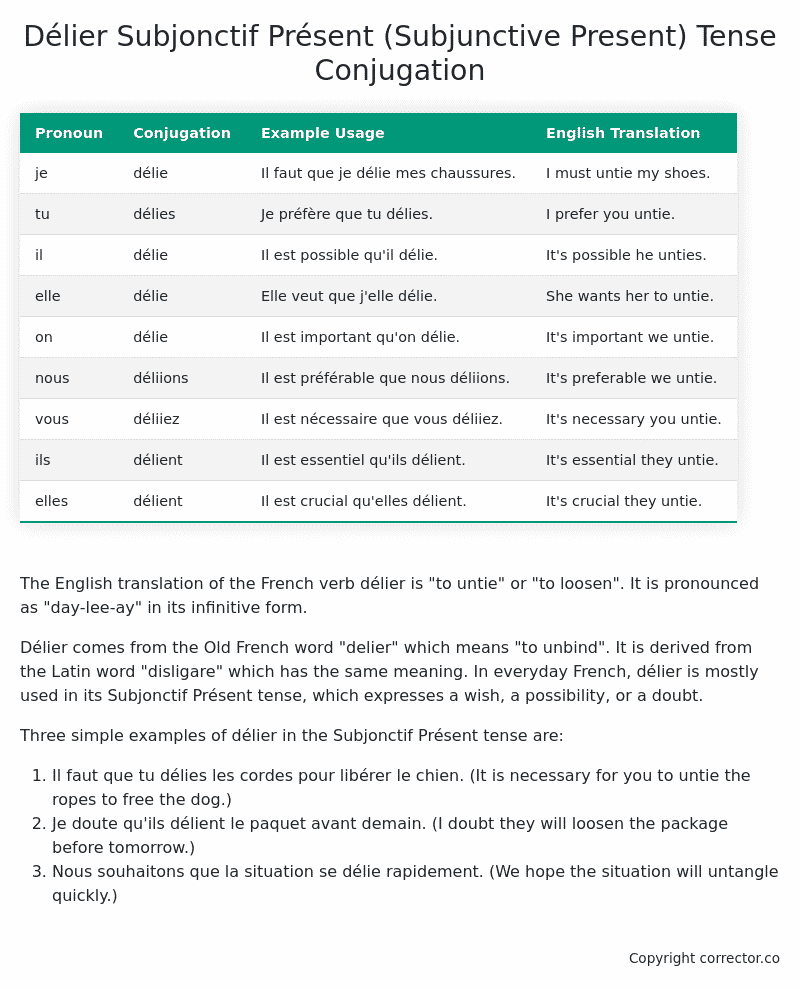Subjonctif Présent (Subjunctive Present) Tense Conjugation of the French Verb délier
Introduction to the verb délier
The English translation of the French verb délier is “to untie” or “to loosen”. It is pronounced as “day-lee-ay” in its infinitive form.
Délier comes from the Old French word “delier” which means “to unbind”. It is derived from the Latin word “disligare” which has the same meaning. In everyday French, délier is mostly used in its Subjonctif Présent tense, which expresses a wish, a possibility, or a doubt.
Three simple examples of délier in the Subjonctif Présent tense are:
- Il faut que tu délies les cordes pour libérer le chien. (It is necessary for you to untie the ropes to free the dog.)
- Je doute qu’ils délient le paquet avant demain. (I doubt they will loosen the package before tomorrow.)
- Nous souhaitons que la situation se délie rapidement. (We hope the situation will untangle quickly.)
Table of the Subjonctif Présent (Subjunctive Present) Tense Conjugation of délier
| Pronoun | Conjugation | Example Usage | English Translation |
|---|---|---|---|
| je | délie | Il faut que je délie mes chaussures. | I must untie my shoes. |
| tu | délies | Je préfère que tu délies. | I prefer you untie. |
| il | délie | Il est possible qu’il délie. | It’s possible he unties. |
| elle | délie | Elle veut que j’elle délie. | She wants her to untie. |
| on | délie | Il est important qu’on délie. | It’s important we untie. |
| nous | déliions | Il est préférable que nous déliions. | It’s preferable we untie. |
| vous | déliiez | Il est nécessaire que vous déliiez. | It’s necessary you untie. |
| ils | délient | Il est essentiel qu’ils délient. | It’s essential they untie. |
| elles | délient | Il est crucial qu’elles délient. | It’s crucial they untie. |
Other Conjugations for Délier.
Le Present (Present Tense) Conjugation of the French Verb délier
Imparfait (Imperfect) Tense Conjugation of the French Verb délier
Passé Simple (Simple Past) Tense Conjugation of the French Verb délier
Passé Composé (Present Perfect) Tense Conjugation of the French Verb délier
Futur Simple (Simple Future) Tense Conjugation of the French Verb délier
Futur Proche (Near Future) Tense Conjugation of the French Verb délier
Plus-que-parfait (Pluperfect) Tense Conjugation of the French Verb délier
Passé Antérieur (Past Anterior) Tense Conjugation of the French Verb délier
Futur Antérieur (Future Anterior) Tense Conjugation of the French Verb délier
Subjonctif Présent (Subjunctive Present) Tense Conjugation of the French Verb délier (this article)
Subjonctif Passé (Subjunctive Past) Tense Conjugation of the French Verb délier
Subjonctif Imparfait (Subjunctive Imperfect) Tense Conjugation of the French Verb délier
Subjonctif Plus-que-parfait (Subjunctive Pluperfect) Tense Conjugation of the French Verb délier
Conditionnel Présent (Conditional Present) Tense Conjugation of the French Verb délier
Conditionnel Passé (Conditional Past) Tense Conjugation of the French Verb délier
L’impératif Présent (Imperative Present) Tense Conjugation of the French Verb délier
L’infinitif Présent (Infinitive Present) Tense Conjugation of the French Verb délier
Struggling with French verbs or the language in general? Why not use our free French Grammar Checker – no registration required!
Get a FREE Download Study Sheet of this Conjugation 🔥
Simply right click the image below, click “save image” and get your free reference for the délier Subjonctif Présent tense conjugation!

Délier – About the French Subjonctif Présent (Subjunctive Present) Tense
Formation of the Subjonctif Présent
Common Everyday Usage Patterns
Interactions with Other Tenses
Summary
I hope you enjoyed this article on the verb délier. Still in a learning mood? Check out another TOTALLY random French verb conjugation!


